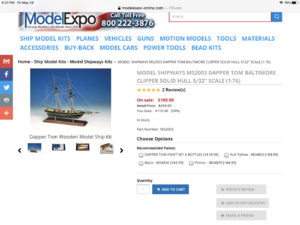What is a good beginner's model kit to start with?
The following Ship Model Kits are often recommended:
| Other Models | | |
|---|
| "Advanced" Beginner's Sailing Ship Models | | |
|---|
| Wooden Sailing Ship Models | | |
|---|
| Bluejacket | Wendameen (1916)
We're Here | Resin kit |
| Midwest Products | ANY Midwest kit marked "beginner".
The Chesapeake Bay Flattie, Dinghy and Boston Whitehall Tender are recommended. | Midwest is very explicit about the skills needed to build each of those small kits, so it should be easy for any beginning modeler, with any skills set, to make an appropriate choice. And the instructions are Excellent! |
| Model Expo | Swift (AL)
Scottish Maid (AL)
Armed Virginia Sloop (Model Shipways)
Scotland (Corel) | All are Plank on Bulkhead |
| The Lumberyard | Lively | Plank on Frame |
| Model Expo | Emma C. Berry | Plank on Frame |
| Amati cannon kits | carronade
French naval cannon | |
Note that this list does
NOT contain most of the popular European kits - European kits typically suffer from poor instructions and plans, inadequate research, and excessive complexity for a beginner -- only a small fraction of these kits sold are ever completed.
{
John O. Kopf}
I am a strong proponent of Keith Julier's books (
Period Ship Modeling I,
II and
III). For those who may not be familiar with them, each chapter provides a profusely illustrated description of the assembly of a commercially available kit. IMHO one of these books would be ideal for any beginner...particularly one who started with a Spanish or Italian kit.
{Joel Labow}
A number of you have written in support of Keith Julier's books
Period Ship Modeling vol. NN. Here's my $0.02.
The theme of these books is: "What will one of the [insert European kit manufacturer's names here] kits look like if I built it straight from the box?" Each "chapter" covers one kit, with maybe a dozen b/w photos of his kit in progress. Every absurdity of the Euro kits is included, from lower hull planking ending on the wales, bright brass fittings, painted and "grouted" tiles representing copper plating, to the ridiculous head representations on several of the kits. He did include one Model Shipways kit (Pride of Baltimore II). Ben Lankford's clear instructions and the intricacies of proper planking technique required for a single-planked job (e.g. spiling) seem to come as a revelation to him.
These books are reasonable if you got a European double-planked kit for Christmas and don't know what to do with. It's also a good warning as to the limitations of these kits. Save your money if you've got a model or two under your belt and want to produce something to superior to "out of the box."
{
Douglas Simpkin}
Most modelers enter the hobby from plastic kits. (They migrate to sailing ships from plastic aircraft or modern ships). To many, the jump from plastic non-sailing ships to a wooden sailing ship is too big. They become intimidated.
Some good plastic kits do exist, that are suitable as beginner kits. These include the Heller 1:75
NINA and
PINTA. (Little jewels, although some filling is required. Also, I suspect they are really 1:90 -- compare the hulls to the 1:100 plans in Pastor's
Ships of Christopher Columbus). Don't waste time on the Revell Columbus ships. They are useful for fittings, but of much lower quality than the Heller kits.
Another possiblity is the Airfix 1:72
Golden Hind. This has more complex rigging, but simpler than say, the Revell 1:96
Constitution. If you do not mind using stretched sprue, the Airfix
Great Western is fun, too. The sail plan is simplified because it is a paddle steamer, but there is enough to be fun. I would recommend that only to an experienced plastic modeler who is a neophyte in sailing ships.
An advantage to plastic kits is that you rig them just like the wooden kits. Rigging tends to be the biggest challenge in a sailing ship model. Get comfortable with rigging, and going to wood doesn't seem so scary.
{
Mark Lardas}
The Airfix
Golden Hind needs some serious work, namely the foremast moved. If a real sailing ship had a mast where it is on the model, that mast would have very little support below the decks. I've been on board the "real"
Golden Hind, i.e. the latter day full size replica, whose masts extend down into the guts of the ship, which is impossible on the ship depicted by Airfix. To make matters worse, the model lacks parts for anything much smaller than a cannon. If you want "something that does NOT resemble a toy", steer clear of this kit.
The Airfix
HMS Victory is a better model. Unlike the
Golden Hind, it includes minor details such as a figurehead and wheel. For a beginner, it requires a good amount of effort, as will any sailing ship model that size, but it can be done. It was my first large sailing ship model, so I speak from beginner's experience.

{
Adrian Hurt}
A good point...If you're unfamiliar with ships (either sailing
or power), an inexpensive plastic model will help you recognize the various parts of the ships, and help begin to familiarize you with some of the problems you'll encounter (such as few straight lines, flat surfaces, and the need to review the plans and instructions before you "paint your self into a corner" by installing one part that blocks the installation of a second part).
{
John O. Kopf}
I recommend you obtain a wood ship model kit that comes with an instruction book which describes the
details of the prototype vessel, or vessels of the very type you are modeling. In other words, the plans and general instructions rarely give a novice enough information on what the rigging details look like, or how to reproduce them in scale.
Start out with a fishing vessel which has one or two masts, and is not square-rigged. I have a modest library of ship model books from the 1970s, but none of them is likely to be of a lot of help in completing a particular model, so I won't recommend any.
Bear in mind that experienced ship modellers often junk the wood strips supplied in the kit and replace it with strips sawn from very hard, fine-grained wood like maple, apple, pearwood and boxwood.
Good quality woodworking tools tend to be lot more costly than the tools required for plastic kits.
{
Septimus}
Before you run to the Candy Store with your check book you should take a moment to seriously consider the following points.
- How much time and effort are you willing to put into the work?
- How much money can you afford to invest?
- How do you rate your own ability?
- Do you have a mentor or someone who can assist you when you have a problem?
- What sort of space do you have to display your work?
- What type of ship do you want to build?
- What is your actual purpose in building?
Keep it simple! Reflect a moment on your needs, wants, and desires. Don't let your current enthusiasm carry you overboard into deep water. Be honest with yourself!
In the selection of a kit. You may have already obtained a catalog from Model Expo. This is a good start. However, before you buy anything, make a visit to a local Hobby Shop and check out some of the Kits they have available. Ask the clerk if you can look at the contents of a kit and check out the plans, Instructions, materials (wood, Fittings, etc.) to see what they look like, and in what condition the material is in. Parts get damaged in shipment or handling. Spend a little time to look at various kits.
A Plug for Model Expo is their Unconventional Guarantee noted in their catalog. Read it. I haven't seen this in other Mail Houses to date, but you can bet that your local dealer doesn't carry one like it. I had planned to order some of their kits, but they never responded to my request for assistance. Maybe I asked them the wrong questions.
The Kit you finally select is your choice. When the kit arrives, take time to check it out before you attempt to cut any wood. Look at the condition of the contents of the box. Check the
BOM (Bill of Materials) against the actual parts. Check that the wood is not split, chipped, or damaged, and the number of pieces listed are there. Check all the fittings for condition and Quantity. Check the instructions and plans. In other words, make sure that everything that is suppose to be there is. Mistakes and/or accidents happen and parts or materials sometime get broken or not get put into the box. If there is anything wrong, notify the people you bought the kit from to correct the problem, before you start. Most companies offer a 30 day Guarantee (but only in the original condition).
This may excite the Armchair Admirals but do not concern yourself with scale, history, modifications, or anything else at this time. Concern yourself with these things later on if you decide to continue the hobby. Kits are made to be put together as is. The idea is to enjoy building and the pleasure of displaying a job well done. So what if there are minor errors, it's to be expected your first time out. No-one becomes a master anything over night! The more your learn, the more you find that you have to learn.
Again don't go overboard, there are too many people who start out with high enthusiasm and ambitions only to have it peter out when they realize the enormous task they face. But if you start within your means and work slowly and steadily your can see the result of your work and show it with pride. I built that myself!!
I've enjoyed this hobby for over 25 years it requires both time and patience. Good Luck!!













